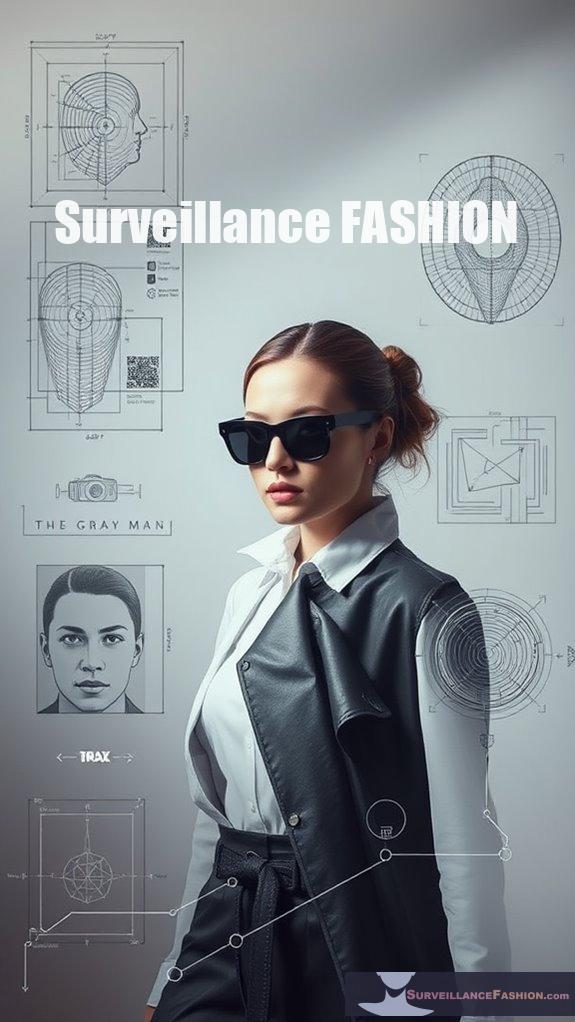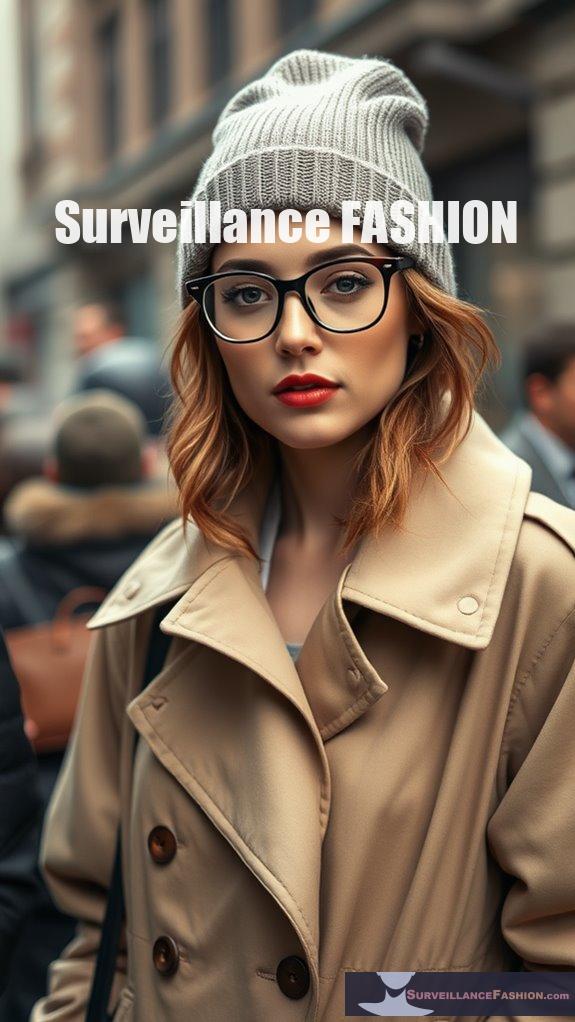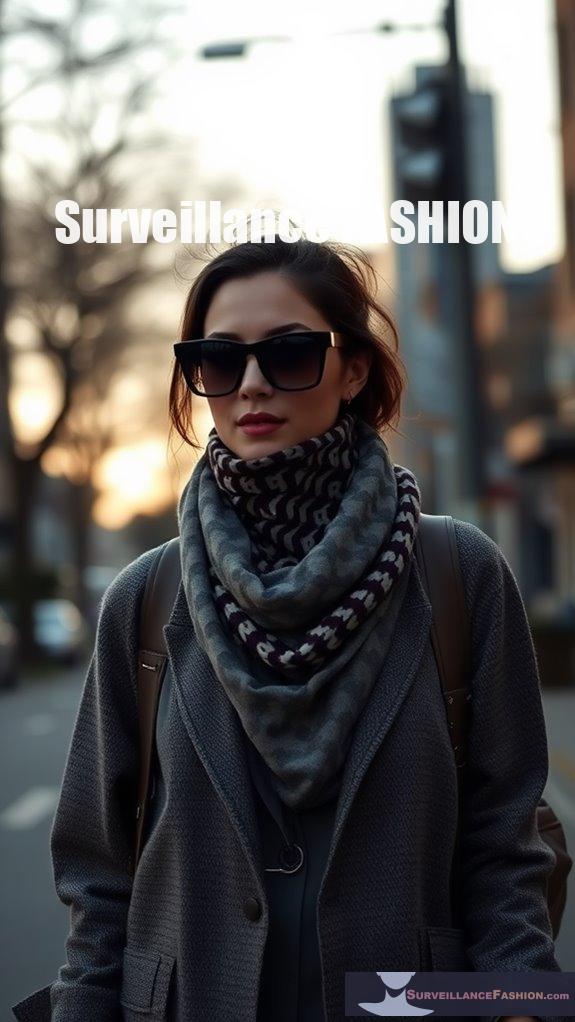To effectively evade facial recognition, utilize techniques like bold makeup, unconventional hairstyles, and strategic clothing choices that present confusing patterns. For instance, wearing high-contrast colors and asymmetrical designs can bewilder detection algorithms by obscuring essential facial features. In addition, employing light-sensitive glasses or masks can further disrupt recognition efforts, ensuring your privacy is maintained. By understanding the intricacies of these methods, you can navigate a world increasingly saturated with surveillance, and you’ll uncover more effective strategies along the way.
Quick Takeaways
- Use light-sensitive glasses that create patterns invisible to the human eye, disrupting facial recognition technology under certain lighting conditions.
- Employ bold makeup and asymmetrical hairstyles to obscure key facial landmarks and confuse recognition algorithms.
- Consider wearing masks or strategically placed accessories to occlude parts of your face, misleading facial recognition systems.
- Engage in strategic movement patterns to avoid detection, making it harder for cameras to track your movements.
- Maintain a low online presence to prevent the sharing of identifiable images, enhancing your digital anonymity.
Techniques for Evading Facial Recognition

In an era where facial recognition technology permeates everyday life, understanding how to maneuver and evade these systems has become increasingly pertinent, especially for individuals seeking privacy and autonomy. The rise of biometric systems has led many to explore various disguise techniques, which can serve as effective tools in safeguarding one’s identity against invasive surveillance practices.
To begin with, comprehending the mechanics of the Viola-Jones face detector is essential. This algorithm identifies facial features through specific patterns, making it vital for you to manipulate those features to remain undetected. By employing makeup and altering your hairstyle, you can create subtle shifts in your appearance that may confuse the system, complicating its ability to classify you correctly. For instance, a bold lip color or a different hairstyle can obscure key facial landmarks, providing a layer of protection against recognition. The operation of facial recognition systems relies heavily on accurate feature extraction, which means that any alterations you make can significantly impact the system’s effectiveness. Understanding biometric data collection can enhance your strategies for evasion, employing creative methods like light projection techniques can obscure your face in real-time, making it even harder for recognition systems to pinpoint your identity.
Understanding the Viola-Jones face detector allows you to cleverly manipulate your features, enhancing your ability to evade recognition.
Another intriguing method involves the use of light-sensitive glasses. These glasses create patterns that are invisible to the human eye but can disrupt how cameras perceive your face, rendering you unrecognizable in certain lighting conditions. While this may sound like science fiction, the technology exists and showcases the lengths individuals can go to in pursuit of biometric privacy.
Occlusion techniques, such as wearing masks or strategically placed glasses, can also be effective. By covering parts of your face, you can mislead facial recognition models, which rely on full facial data to make accurate identifications. The effectiveness of this approach, however, is contingent on the specific systems in use, as advanced algorithms may still detect certain patterns or features. Consequently, understanding the limitations and capabilities of the facial recognition technology in your environment is paramount.
Dodging attacks represent another fascinating aspect of evading facial recognition, as they aim to misclassify your face entirely. This technique is particularly pertinent for those who wish to maintain their privacy without engaging in overly elaborate disguises. The idea is to present a face that the system interprets as someone entirely different, thereby bypassing identification altogether.
As you consider these methods, it’s also important to recognize the ongoing advancements in security measures against evasion tactics. Liveness detection, for instance, can discern whether a system is interacting with a real person or a mere prop, enhancing the security protocols in place. Moreover, motion-based anti-spoofing methods can identify static presentations, underscoring the need for dynamic behavior to reinforce authenticity.
Engaging with these techniques, while potentially effective, also reveals the complexities of maneuvering a world increasingly dominated by surveillance. The delicate balance between utilizing disguise techniques and understanding the shifting terrain of biometric privacy is essential for anyone wishing to reclaim their autonomy in this digital age.
This journey toward privacy is precisely why we created Surveillance Fashion, to empower individuals like you with the knowledge and tools necessary to protect oneself against the encroaching gaze of technology. By mastering these evasion techniques, you stand a better chance of maintaining your individuality amidst a sea of digital observation.
Style Tips for Evasion

While steering through a world increasingly dominated by facial recognition technology, employing strategic style choices can greatly enhance your ability to evade detection.
Consider these four effective style tips:
- Invisible Patterns: Incorporate designs that confuse algorithms, creating non-human shapes that disrupt recognition. These patterns can include geometric illusions that further obscure your true form.
- High-Contrast Makeup: Use bold colors that stand out against your skin tone, thereby complicating the system’s ability to identify your features accurately.
- Asymmetrical Looks: Covering one eye or opting for asymmetrical hairstyles can create facial irregularities, further complicating detection.
- Clothing with Faces: Outfitting yourself in garments that display multiple faces can overload detection systems, making your true identity hard to ascertain.
Additionally, utilizing anti-facial recognition techniques can further enhance your camouflage by incorporating unconventional makeup styles that mask your identity.
Recognition Evasion Strategy Guide

A thorough understanding of recognition evasion strategies is essential for traversing a territory increasingly defined by facial recognition technologies.
With privacy laws often lagging behind advancements in this field, individuals must adopt proactive measures to guarantee digital anonymity. Strategic movement patterns can significantly enhance your ability to evade detection.
Begin by manipulating your appearance through complex patterns or makeup to disrupt recognition algorithms.
For instance, using specialized accessories like infrared LED glasses can confuse facial detection systems, rendering you less identifiable.
Controlling your online presence is critical; avoid sharing identifiable images on social media, which can feed into recognition databases.
Engaging in discussions about the ethical implications of surveillance fosters public awareness, potentially leading to stronger privacy protections.
Practicing physical distancing from surveillance points can significantly reduce the likelihood of being captured by facial recognition systems.
Ultimately, as we navigate this transforming environment, recognizing the limitations of existing technologies and advocating for meaningful legal reforms can empower us to reclaim our privacy, an endeavor that inspired the creation of Surveillance Fashion.
References
- https://users.ece.cmu.edu/~lbauer/papers/2016/ccs2016-face-recognition.pdf
- https://ftp.idu.ac.id/wp-content/uploads/ebook/ip/BUKU MANAJEMEN SAFETY/SAFETY INDUSTRY/Principles of Forensic Engineering Applied to Industrial Accidents by Luca Fiorentini
- https://www.riskinsight-wavestone.com/en/2024/06/the-different-faces-of-facial-recognition-operation-and-attacks/
- https://www.178wing.ang.af.mil/Portals/69/documents/afh33-337.pdf?ver=2016-12-15-101008-313
- https://www.idnow.io/blog/fraud-detection-anti-spoofing-facial-recognition/
- https://www.mypatriotsupply.com/blogs/scout/stay-incognito-top-tips-to-evade-facial-recognition-technology
- https://www.stratecta.exchange/fashion-that-can-beat-facial-recognition-systems/
- https://www.popularmechanics.com/technology/security/g28719483/trick-surveillance-systems/
- https://www.theregister.com/2025/01/15/make_up_thwart_facial_recognition/
- https://www.businessinsider.com/clothes-accessories-that-outsmart-facial-recognition-tech-2019-10

Leave a Reply